Telescopium constellation lies in the southern sky, south of Sagittarius and Corona Australis.
As the name indicates, Telescopum represents the telescope. The constellation was created by the French astronomer Nicolas Louis de Lacaille in the 18th century. Lacaille named it after a type of telescope in honour of its invention.
The constellation is a relatively faint one, with no stars brighter than fourth magnitude. It also has relatively few notable deep sky objects. It is home to the Telescopium Group, a group consisting of about 12 galaxies.
Facts, location and map
Telescopium is the 57th constellation in size, occupying an area of 252 square degrees. It is located in the fourth quadrant of the southern hemisphere (SQ4) and can be seen at latitudes between +40° and -90°. The neighboring constellations are Ara, Corona Australis, Indus, Microscopium, Pavo and Sagittarius.
The constellation name Telescopium is pronounced /ˌtɛlɪˈskɒpiəm/. In English, the constellation is known as the Telescope. The genitive form of Telescopium, used in star names, is Telescopii (pronunciation: /ˌtɛlɪˈskɒpiaɪ/). The three-letter abbreviation, adopted by the International Astronomical Union (IAU) in 1922, is Tel.
Telescopium belongs to the Lacaille family of constellations, along with Antlia, Caelum, Circinus, Fornax, Horologium, Mensa, Microscopium, Norma, Octans, Pictor, Reticulum and Sculptor.
Telescopium does not have any stars with confirmed planets nor does it contain any Messier objects. The brightest star in the constellation is Alpha Telescopii, with an apparent magnitude of 3.49. There are no meteor showers associated with the constellation.
Telescopium does not contain any formally named stars.
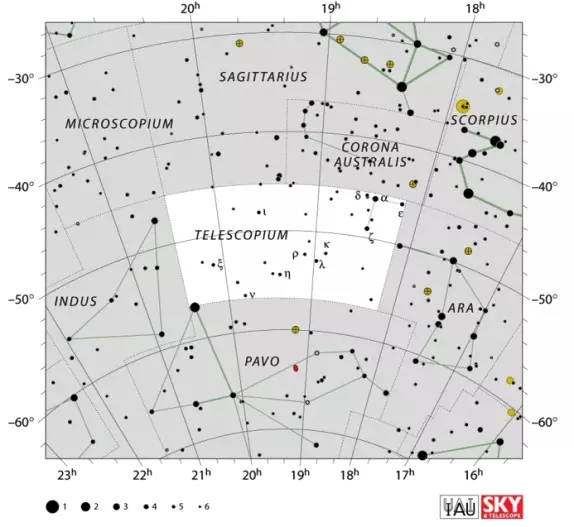
Telescopium constellation map by IAU and Sky&Telescope magazine
Story
Telescopium is not associated with any myths. The constellation was introduced by the French astronomer Nicolas Louis de Lacaille, who mapped the southern skies from the Cape of Good Hope in South Africa in 1751-1752. It represents an aerial telescope, a type of refractor that was used by J.D. Cassini at Paris Observatory.
As defined by Lacaille, the constellation originally extended to the north between Sagittarius and Scorpius, but what used to represent the top of the telescope’s tube and mounting was cut off later. The official boundaries of the constellation were set by the Belgian astronomer Eugène Delporte in 1930.
Today, Telescopium takes up a region of the sky south of the constellations Sagittarius and Corona Australis.
The star that was placed in the pulley at the top of the mast by Lacaille and designated Beta Telescopii became Eta Sagittarii and the star that used to be Gamma Telescopii and was positioned in the upper part of the telescope’s tube, became G Scorpii in Scorpius constellation. The former Theta Telescopii, which used to mark the objective lens on the refractor, was moved to Ophiuchus as designated 45 Ophiuchi.
The constellation was also sometimes known as Tubus Astronomicus, but this name is long obsolete.
Telescopium stars
α Telescopii (Alpha Telescopii)
Alpha Telescopii is a blue-white subgiant star with the stellar classification of B3 IV. It is the brightest star in Telescopium constellation. It has an apparent magnitude of 3.51 and is approximately 278 light years distant from Earth.
Before Lacaille created the constellation, the star belonged to Corona Australis, where Ptolemy placed it in the 2nd century.
Alpha Telescopii has five times the Sun’s mass and three times the solar radius. It is almost 800 times more luminous than the Sun. The star is classified as a slowly pulsating B star (SPB), which is a type of variable star.
ζ Telescopii (Zeta Telescopii)
Zeta Telescopii is a yellow giant star belonging to the spectral class G. It has a visual magnitude of 4.10 and is about 127 light years distant from Earth. It is the second brightest star in Telescopium.
ε Telescopii (Epsilon Telescopii)
Epsilon Telescopii is a binary star system in Telescopium. It has the stellar classification of K0III, and the primary component is an orange giant with an apparent magnitude of 4.52. The companion is a 13th magnitude star, separated from the primary by 21 seconds of arc. The system is approximately 420 light years distant from the Sun.
λ Telescopii (Lambda Telescopii)
Lambda Telescopii is the fourth brightest star in the constellation. It is a white main sequence dwarf with the stellar classification of A0V. It has an apparent magnitude of 4.85 and is approximately 531 light years distant from the solar system.
ι Telescopii (Iota Telescopii)
Iota Telescopii is an orange giant belonging to the stellar class K0III. It has an apparent magnitude of 4.88 and is about 398 light years distant from Earth.
δ Telescopii (Delta Telescopii)
Delta Telescopii is a Bayer designation used for two stars, Delta-1 Telescopii and Delta-2 Telescopii. The two are separated by 0.16 degrees in the sky.
Delta-1 Telescopii is a blue-white subgiant star of the spectral type B6IV. It has an apparent magnitude of 4.92 and is approximately 800 light years distant from Earth.
Delta-2 Telescopii is a blue-white giant with the stellar classification of B3III. It has a visual magnitude of 5.07 and is about 1,100 light years distant.
ξ Telescopii (Xi Telescopii)
Xi Telescopii is a red bright giant belonging to the stellar class M1IIab. It has an apparent magnitude of 4.93 and is approximately 1,250 light years distant from the solar system. It is classified as an irregular variable star. Its luminosity varies from magnitude 4.89 to 4.94.
η Telescopii (Eta Telescopii)
Eta Telescopii is a white main sequence star with the stellar classification of A0 Vn. It has an apparent magnitude of 5.03 and is approximately 155 light years distant. The star is a member of the Beta Pictoris Moving Group of stars, which all share a common motion through space.
Eta Telescopii has 2.9 times the Sun’s mass and is about 22 times more luminous than the Sun. It has an estimated age of about 12 million years. The star likely has a circumstellar dust disk in its orbit as it emits an excess of infrared radiation.
ρ Telescopii (Rho Telescopii)
Rho Telescopii is a class F dwarf belonging to the stellar class F6 V. It has an apparent magnitude of 5.17 and is about 185 light years distant from the solar system. The star has a mass 2.6 times that of the Sun.
κ Telescopii (Kappa Telescopii)
Kappa Telescopii is a yellow giant star with a visual magnitude of 5.18. It is approximately 293 light years distant from Earth. The star has almost 11 times the Sun’s radius and 1.6 times the mass. It has an estimated age of 1.9 billion years.
ν Telescopii (Nu Telescopii)
Nu Telescopii is a white giant star with the stellar classification of A7II-IV. It has an apparent magnitude of 5.33 and is approximately 170 light years distant from the solar system. It is about 250 million years old.
μ Telescopii (Mu Telescopii)
Mu Telescopii is a class F main sequence dwarf with an apparent magnitude of 6.29. It is about 120 light years distant from the Sun. It belongs to the stellar class F5V.
HIP 92367 (30 G. Telescopii)
HIP 92367 is a yellow giant star with the stellar classification of G8 III. It has a visual magnitude of 5.802 and is approximately 360 light years distant from the solar system. The star can be seen without binoculars in good viewing conditions. It has the same mass as the Sun and three times the solar radius.
Deep sky objects in Telescopium
NGC 6850
NGC 6850 is a spiral galaxy in Telescopium. It was discovered by the English astronomer John Herschel in June 1836. It has an apparent magnitude of 12.6.
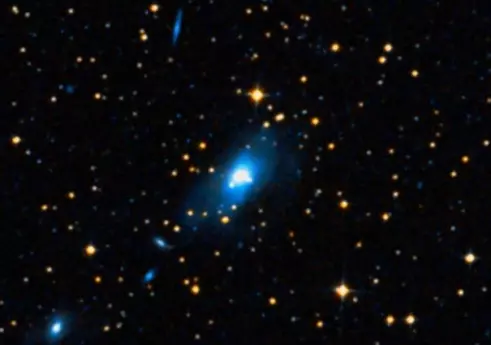
NGC 6850, image: Wikisky
IC 4699
IC 4699 is a planetary nebula in Telescopium. It is located near Alpha Telescopii and the border with the constellation Corona Australis. The nebula can be seen in a 200 mm telescope. It has an apparent magnitude of 13.
NGC 6584
NGC 6584 is a globular cluster with an apparent magnitude of 7.9. It is approximately 44,000 light years distant from Earth.
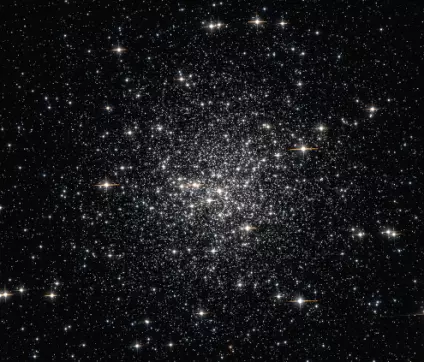
NGC 6584 – Based on observations made with the NASA/ESA Hubble Space Telescope, and obtained from the Hubble Legacy Archive, which is a collaboration between the Space Telescope Science Institute (STScI/NASA), the Space Telescope European Coordinating Facility (ST-ECF/ESA) and the Canadian Astronomy Data Centre (CADC/NRC/CSA).
Telescopium Group– AS0851
The Telescopium Group is a galaxy group consisting of 12 member galaxies and spanning three degrees in the northeastern part of the constellation.
The galaxies are approximately 120 million light years distant from the Milky Way. The brightest members in the group are the galaxies NGC 6868 and NGC 6861.
NGC 6861
NGC 6861 is a lenticular galaxy with an apparent magnitude of 11. It occupies an area of 3 by 2 arc minutes of apparent sky and is the second brightest object in the Telescopium Group. It is interacting with the brighter NGC 6868 and the two will eventually merge into a single galaxy.
NGC 6861 was discovered by the Scottish astronomer James Dunlop in 1826.
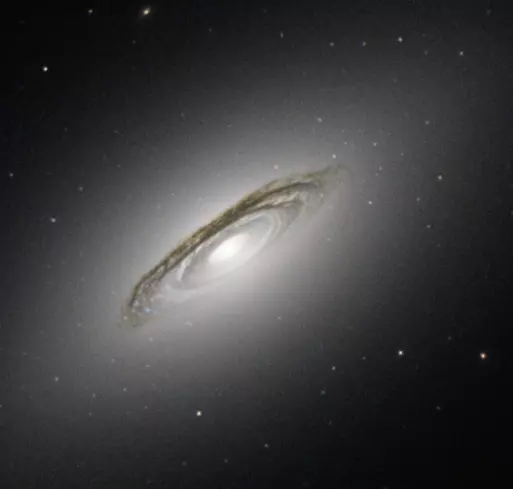
NGC 6861, image: ESA/Hubble & NASA Acknowledgement: J. Barrington
NGC 6868
NGC 6868 is a giant elliptical galaxy in Telescopium. It is the brightest galaxy in the Telescopium Group. It was discovered by John Herschel in July 1834.
NGC 6868 has an apparent magnitude of 10.6. The galaxy has recently collided with another galaxy, most likely a spiral. It has large, young stars and clouds of dust in its central region, and these are not typically found in large elliptical galaxies.
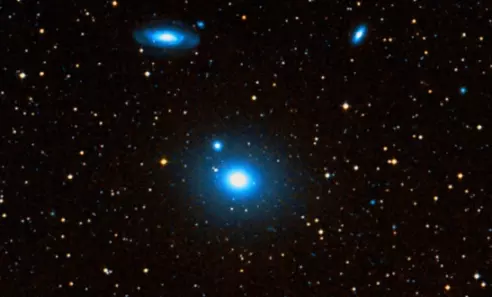
NGC 6868, image: Wikisky